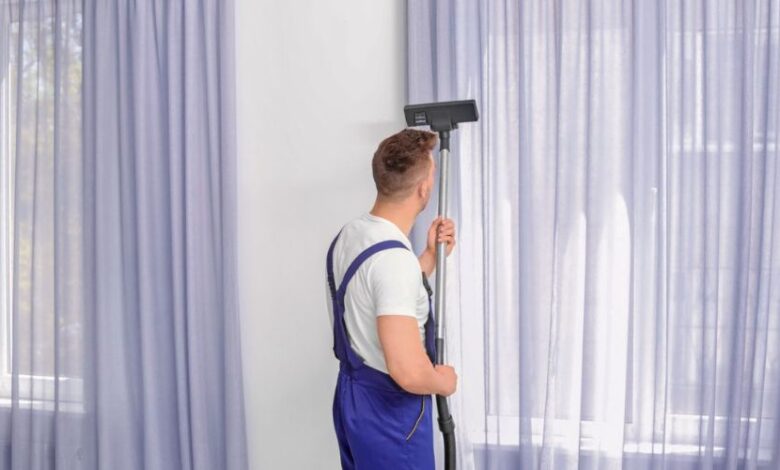How to Clean and Maintain Your Curtains?

Curtains are essential elements of home decor, contributing to the overall aesthetics of your living space while providing privacy and insulation. However, like any other household item, curtains require regular cleaning and maintenance to keep them looking fresh and functional. In this guide, we’ll explore the steps to clean and maintain your curtains effectively, ensuring they remain in top condition for years to come.
Understanding Your Curtains: Fabric and Care Labels
Before diving into the cleaning process, it’s crucial to understand the fabric type of your curtains Dubai. Different fabrics require different cleaning methods. Common curtain fabrics include:
- Cotton: Durable and easy to clean, often machine-washable.
- Linen: Requires gentle handling, typically dry-clean only.
- Silk: Delicate and prone to water damage; it usually needs professional cleaning.
- Velvet: Heavy and luxurious, often needs dry cleaning.
- Synthetic fabrics (polyester, nylon): Generally easy to care for, many are machine-washable.
For precise washing and drying instructions, don’t forget to consult the sewn-in label on your curtains. Ignoring these can lead to damage and reduce the lifespan of your curtains.
Regular Maintenance: Dusting and Vacuuming
By consistently caring for your curtains, you can noticeably enhance their lifespan. Dust and dirt can accumulate on the fabric, leading to discoloration and wear over time. Here’s how to keep your curtains dust-free:
- Weekly Dusting:
- Use a feather duster or a microfiber cloth to gently remove dust from your curtains.
- For thorough cleaning, begin at the highest point and systematically work your way down the curtain surface.
- Vacuuming:
- Attach a soft brush to your vacuum cleaner and set it to a low suction setting.
- Vacuum your curtains monthly, paying extra attention to the folds and hems where dust tends to accumulate.
Spot Cleaning: Addressing Stains Immediately
Accidents happen, and when they do, it’s essential to address stains promptly to prevent them from setting. Here’s how to spot-clean your curtains:
- Identify the Stain:
- Determine the type of stain (e.g., food, ink, grease) to choose the appropriate cleaning solution.
- Blot, Don’t Rub:
- For stain removal, gently dab the affected area using a clean, white cloth. Rubbing can push the stain deeper into the fabric and cause damage.
- Cleaning Solution:
- For most stains, a mixture of mild detergent and water will suffice. For tougher stains, consider using a specialized fabric cleaner.
- Test the solution on a small, inconspicuous area first to ensure it doesn’t damage or discolor the fabric.
- Blot Again:
- After applying the cleaning solution, blot the area with a clean, damp cloth to remove any residue.
Machine Washing: When and How
Machine washing is suitable for many curtain fabrics but always check the care label first. For a sparkling clean, proceed with these steps:
- Pre-Treat Stains:
- Spot-clean any visible stains before machine washing.
- Remove Hardware:
- Begin by carefully detaching your curtains and removing any hooks, rings, or other hardware.
- Gentle Cycle:
- Use a gentle or delicate cycle with cold water to prevent shrinkage and damage.
- Mild Detergent:
- Opt for a gentle detergent formulated for delicate fabrics.
- Avoid Overloading:
- Do not overload the washing machine. Curtains need space to move around to be cleaned effectively.
- Drying:
- Hang the curtains to dry naturally, preferably outdoors. Hang your curtains to dry out of direct sunlight, which can cause fading.
- If you must use a dryer, choose a low-heat setting and remove the curtains while they are still slightly damp to minimize wrinkles.
Hand Washing: For Delicate Fabrics
Handwashing is ideal for delicate fabrics like silk and lace. Here’s how to do it:
- Fill a Basin:
- Prepare a gentle soak for your curtains by filling a basin or bathtub with lukewarm water and a touch of mild detergent.
- Submerge Curtains:
- Submerge the curtains and gently agitate the water with your hands.
- Soak and Rinse:
- Let the curtains soak for 10–15 minutes, then drain the soapy water and refill the basin with clean water to rinse.
- Gently Squeeze:
- Gently squeeze out excess water without wringing the fabric, which can cause damage.
- Drying:
- Hang the curtains to dry, avoiding direct sunlight.
Professional Cleaning: When to Seek Help
Some curtains, especially those made from delicate fabrics like velvet and silk or those with intricate details, require professional cleaning. Consider professional cleaning if:
- The care label specifies dry cleaning only.
- The curtains are heavily soiled or stained.
- The fabric is delicate or prone to damage.
Professional cleaners have the expertise and equipment to handle delicate fabrics safely and effectively.
Ironing and Steaming: Keeping Curtains Wrinkle-Free
Curtains are prone to becoming wrinkled and creased, particularly after going through a wash cycle. Here’s how to keep them looking smooth and crisp:
- Ironing:
- Check the care label to ensure the fabric can be ironed.
- Use a low heat setting and iron the curtains on the reverse side to prevent damage.
- For large curtains, consider using an ironing board extension or ironing on a clean, flat surface.
- Steaming:
- Use a handheld steamer to remove wrinkles from hanging curtains.
- Hold the steamer a few inches away from the fabric and move it slowly from top to bottom.
Preventive Measures: Extending the Curtain Lifespan
Taking preventive measures can help extend the life of your curtains and reduce the need for frequent cleaning.
- Use Curtain Liners:
- Curtain liners can protect the fabric from dust, sunlight, and moisture.
- Rotate Curtains:
- If possible, rotate your curtains periodically to distribute wear and tear evenly.
- Regular Inspection:
- Inspect your curtains regularly for signs of damage or wear. Proactive maintenance can nip minor curtain issues in the bud before they snowball into bigger problems.
- Maintain a Clean Environment:
- Keeping your home clean and dust-free will reduce the amount of dirt that settles on your curtains.
Conclusion
Maintaining your curtains doesn’t have to be a daunting task. By understanding your curtain fabric, performing regular maintenance, addressing stains promptly, and using appropriate cleaning methods, you can keep your curtains looking fresh and new for years. Whether you choose to clean them yourself or seek professional help, the key is consistency and care. Properly maintained curtains not only enhance the beauty of your home but also provide a healthier and more comfortable living environment.



